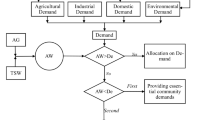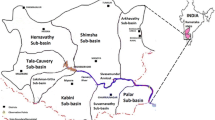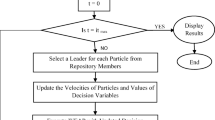Abstract
Efficient, just, and sustainable water resources’ allocation is difficult to achieve in multi-stakeholder basins. This study presents a multi-objective optimization model for water resources allocation and reports its application to the Sefidrud basin in Iran. Available water resources are predicted until 2041with the artificial neural network algorithm (ANN). This is followed by multi-objective optimization of water resource allocation. The first objective function of the optimization model is maximization of revenue, and the second objective function is the achievement of equity in water resources allocation in the basin. This study considers two scenarios in the optimization scheme. The first scenario concerns the water allocation with existing dams and dams under construction. The second scenario tackles water allocation adding dams currently in the study stage to those considered in Scenario 1. The Gini coefficient is about 0.1 under the first scenario, indicating the preponderance of economic justice in the basin. The Gini coefficient is about 0.4 under the second scenario, which signals an increase of injustice in water allocation when considering the future operation of dams currently under study.






Similar content being viewed by others
Data availability
All of the required data have been presented in our article.
Abbreviations
- Variable :
-
Description
- F 1 :
-
First objective function
- C :
-
Index for water use by each stakeholder
- q pc :
-
Amount of water received by stakeholder p for water use c
- AEB pc :
-
Average revenue of water use c and stakeholder p
- Q c :
-
Amount of water allocated to water use c
- Q p :
-
Amount of water allocated to province p
- F 2 :
-
Second objective function
- AEB p :
-
Average revenue from water use by stakeholder p
- k :
-
Counter that is randomly selected among the stakeholders
- AW :
-
Available water
- TSW :
-
Surface water
- AG :
-
Groundwater
- ED :
-
Environmental demand
- DD :
-
Domestic demand
- WA pc :
-
Amount of allocated water to stakeholder p and water use c
- De pc :
-
Water demand of stakeholder p and water use c
References
Aboutalebi, M., Bozorg Haddad, O., & Loáiciga, H. A. (2015). Optimal monthly reservoir operation rules for hydropower generation derived with SVR-NSGA II. Journal of Water Resources Planning and Management, 141(11), 04015029.
Acquah, S., & Ward, F. A. (2019). Water policy interventions for food security in Afghanistan. International Journal of Water Resources Development, 35(1), 49–70.
Asah, S. T. (2015). Transboundary hydro-politics and climate change rhetoric: an emerging hydro-security complex in the Lake Chad basin. Wiley Interdisciplinary Reviews Water, 2(1), 37–45.
Babel, M. S., Das, G. A., & Nayak, D. K. (2005). A model for optimal allocation of water to competing demands. Water Resources Management, 19(6), 693–712.
Bozorg-Haddad, O., and Mariño, M. A. (2011). “Optimum operation of wells in coastal aquifers.” In Proceedings of the Institution of Civil Engineers-Water Management 164(3), 135–146.
Bozorg-Haddad, O., Zarezadeh-Mehrizi, M., Abdi-Dehkordi, M., Loáiciga, H. A., & Mariño, M. A. (2016). A self-tuning ANN model for simulation and forecasting of surface flows. Water Resources Management, 30(9), 2907–2929.
Bozorg Haddad, O., Solgi, M., & Loáiciga, H. A. (2017). Meta-heuristic and evolutionary algorithms for engineering optimization. John Wiley & Sons, Inc.
Deb, K., Pratap, A., Agarwal, S., Meyarivan, T., & Fast, A. (2002). Nsga-ii. IEEE Transactions on Evolutionary Computation, 6(2), 182–197.
Digna, R., Castro-Gama, M., van der Zaag, P., Mohamed, Y., Corzo, G., & Uhlenbrook, S. (2018). Optimal operation of the eastern Nile system using genetic algorithm, and benefits distribution of water resources development. Water, 10(7), 921.
Divakar, L., Babel, M. S., Perret, S. R., & Das, G. A. (2011). Optimal allocation of bulk water supplies to competing use sectors based on economic criterion – an application to the Chao Phraya River Basin, Thailand. Journal of Hydrology, 401(1–2), 22–35.
Fallah-Mehdipour, E., Haddad, O. B., Tabari, M. M. R., & Mariño, M. A. (2012). Extraction of decision alternatives in construction management projects: application and adaptation of NSGA-II and MOPSO. Expert Systems with Applications, 39(3), 2794–2803.
Fallah-Mehdipour, E., Bozorg-Haddad, O., & Mariño, M. A. (2014). Genetic programming in groundwater modeling. Journal of Hydrologic Engineering, 19(12), 04014031. https://doi.org/10.1061/(ASCE)HE.1943-5584.0000987.
Fallah-Mehdipour, E., Bozorg-Haddad, O., & Loáiciga, H. A. (2019). Climate-environment-water: integrated and non-integrated approaches to reservoir operation. Environmental Monitoring and Assessment, 192(60). https://doi.org/10.1007/s10661-019-8039-2.
Ghahreman, B., & Sepaskhah, A. R. (2002). Optimal water allocation of water from a single reservoir to an irrigation project with pre-determined multiple cropping patterns. Irrigation Science, 21(3), 127–137.
Gini, C. (1921). Measurement of inequality of incomes. The Economic Journal, 31(121), 124–126.
Iftekhar, S. M., & Fogarty, J. (2017). Impact of water allocation strategies to manage groundwater resources in Western Australia: equity and efficiency considerations. Journal of Hydrology, 548(1), 145–156.
Iran Ministry of Energy (2020). https://moe.gov.ir, Last access: May 29, 2020.
Jahandideh-Tehrani, M., Bozorg-Haddad, O., & Loáiciga, H. A. (2015). Hydropower reservoir management under climate change: the Karoon reservoir system. Water Resources Management, 29(3), 749–770. https://doi.org/10.1007/s11269-014-0840-7.
Kansal, M. L., and Ekadu, S. (2018). “Hydropolitics in water governance of the Nile River in Africa.” World Environmental and Water Resources Congress 2018, June 3–7, Minnesota.
Kelleher, J. D., Tierney, B. (2018). Data Science. The MIT Press, Cambridge, Massachusetts.
Madani, K., Zarezadeh, M., & Morid, S. (2014). A new framework for resolving conflicts over transboundary rivers using bankruptcy methods. Hydrology and Earth System Sciences, 18(8), 3055–3068.
McCracken, M., & Wolf, A. T. (2019). Updating the Register of International River Basins of the world. International Journal of Water Resources Development, 1–51.
Ng, T. L., Eheart, J. W., Cai, X., & Braden, J. B. (2011). An agent-based model of farmer decision-making and water quality impacts at the watershed scale under markets for carbon allowances and a second-generation biofuel crop. Water Resources Research, 47(9).
Peng, T. A., Zhang, C., Zhou, J., Xia, X., & Xue, X. (2019). Multi-objective optimization for flood interval prediction based on orthogonal chaotic NSGA-II and Kernel extreme learning machine. Water Resources Management, 33, 4731–4748.
Rai, S. P., Wolf, A. T., & Sharma, N. (2017). Hydropolitics and hydropolitical dynamics between India and Nepal: an event-based study. Water Policy, 19(5), 791–819.
Saadatpour, M. (2020). An adaptive surrogate assisted CE-QUAL-W2 model embedded in hybrid NSGA-II_ AMOSA algorithm for reservoir water quality and quantity management. Water Resources Management, 34, 1437–1451.
Sarzaeim, P., Bozorg-Haddad, O., Bozorgi, A., & Loáiciga, H. A. (2017). Runoff projection under climate change conditions with data-mining methods. Journal of Irrigation and Drainage Engineering, 143(8), 04017026.
Sarzaeim, P., Bozorg-Haddad, O., Zolghadr-Asli, B., Fallah-Mehdipour, E., & Loáiciga, H. A. (2018). Optimization of run-of-river hydropower plant design under climate change conditions. Water Resources Management, 32, 3919–3934.
Sneddon, C., & Fox, C. (2006). Rethinking transboundary waters: a critical hydropolitics of the Mekong basin. Political Geography, 25(2), 181–202.
Tennant, D. L. (1976). Instream flow regimens for fish, wildlife, recreation and related environmental resources. Fisheries Magazine, 1(4), 6–10.
Waterbury, J. (1979). Hydropolitics of the Nile valley. New York: Syracuse University Press.
Zhou, Y., Guo, S., Xu, C. Y., Liu, D., Chen, L., & Ye, Y. (2015). Integrated optimal allocation model for complex adaptive system of water resources management (I): methodologies. Journal of Hydrology, 531, 964–976.
Acknowledgments
The authors thank Iran’s National Science Foundation (INSF) for the financial support of this research.
Author information
Authors and Affiliations
Corresponding author
Ethics declarations
Conflict of interest
The authors declare that they have no conflict of interest.
Additional information
Publisher’s note
Springer Nature remains neutral with regard to jurisdictional claims in published maps and institutional affiliations.
Rights and permissions
About this article
Cite this article
Kazemi, M., Bozorg-Haddad, O., Fallah-Mehdipour, E. et al. Inter-basin hydropolitics for optimal water resources allocation. Environ Monit Assess 192, 478 (2020). https://doi.org/10.1007/s10661-020-08439-3
Received:
Accepted:
Published:
DOI: https://doi.org/10.1007/s10661-020-08439-3




